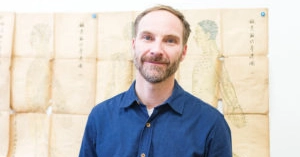Darren Tellier is a full-time acupuncture instructor at MacEwan University. His interest in the field began while he was studying Chinese philosophy and Chinese medicine techniques.
Q: How did you get into teaching acupuncture here at MacEwan?
I started clinical practice here in Edmonton in 2000. Shortly after, I realized that I missed the academic environment. I realized I liked being in an educational institution, either as a student or a teacher, so I came here and asked the program chair if there were any available TA positions. I served as a teaching assistant and then, eventually, they gave me one of my own classes, and then two, in acupuncture studies. I taught a handful of classes part-time for a bit, until I became full-time, and here I am.
Q: What are some of the classes in the acupuncture program?
The program has a lot of different courses. Some of them are conventional biomedicine-based, like pharmacology, physiology, and pathophysiology. Of course, there are all the courses unique to the traditional forms of Chinese medicine that teach the foundational theories, advanced theories, diagnostic theories, clinical lab courses, techniques like needling, all those sorts of things. Just as a small program and as a full-time faculty member, I have to teach a pretty wide variety of courses. Some are lecture, some didactic, some clinical lab courses. I also supervise the clinical lab we have here that is available to the public. Students only get to practice on members of the public in their third year.
Q: Who would be the best candidates for studying acupuncture?
I would say people who obviously have an interest in health.
It’s nice to sort of have a background in some kind of health sciences, have a little bit of anatomy, a little bit of physiology.
You don’t have to be a nurse or something like that. We get a lot of massage graduates, but you don’t need an entire degree. It’s just nice to have some background in all of that stuff.
Q: How do students get to practice acupuncture techniques?
Well, first they get to practice on an orange and inanimate objects. They get to needle inanimate objects, and then they needle themselves in the arm and, eventually, they needle each other under our direction. They do that until their third year and, eventually, they have to work on the public under our supervision.
Q: Are people hesitant that students are working on them in the clinic?
I think most people are aware that it is a student teaching clinic, and they should be reassured that there are professionals keeping a close eye on the students, helping with questions or hands-on advice. The teachers often come in the room and assist them with needling techniques. The clinic is very busy here at MacEwan. There are a lot of patients, so they must not mind too much.
Q: Why is acupuncture beneficial?
It treats a wide variety of problems. I think you could say the best things that are suited to acupuncture are things that you could call the category of malaises or discomfort — something that’s not terribly serious. You don’t need severe medical attention or intervention for it, but it’s definitely affecting the quality of your life. These could be constant nagging back pain or constant headaches that don’t seem to be resolved with medication, or some kind of digestive upset that doesn’t require gastrointestinal surgery or serious medication, but you still want the problem resolved. I think those are a few things suited to being treated with acupuncture.
Q: How has acupuncture changed in recent years?
That’s a really good question, because acupuncture has changed since its inception, and historians and anthropologists actually have a hard time discerning when it started. It’s quite a hot topic of debate, but I would say, arguably, it’s no less than 1,500 to 2,000 years old. Some historians would say it’s much older than that, given some of the things they find, like scrolls in tombs. It seems like there were practices related to that dated farther back. You could get answers like 7,000 to 8,000 years old or only 900 years old. Either way, over that period of time, it has changed a lot because there’s so many different people in different parts of Asia addressing different types of problems or diseases, applying different theories to what they thought was going on. That’s actually continued today because we have different ideas, even in different parts of the world. Acupuncture is practiced in places like Europe, and it’s practiced all over Asia and North America, obviously. So you have people who take the fundamental theories of Chinese medicine and sort of rework them towards the problems of their era, culture or time. Right now, we try to retool acupuncture theories to work on things like stress and burnout, which is a modern problem. Basically, practitioners try to analyze the problem in the context of Chinese medicine, with their vernacular and system of analysis, and then direct the theories to those problems.
Q: Many people are scared of acupuncture because of the needles involved in the process. Are there any reasons that people should be concerned?
It can be dangerous when people who are doing acupuncture don’t have comprehensive training. This is quite a long program. I think it’s about 2,200 hours in total, with clinical hours being about 600. Students are trained in the risks and safety practices around acupuncture — where organs are and how deep they can put needles in, whereas if you take an abbreviated program and don’t have thorough training, then it can be dangerous. You can puncture a lung or things like that. I think the incidents of adverse events, like hitting organs, is really quite low, even compared to other professions. So, there isn’t too much of a risk. In Canada, in five or six provinces, acupuncture is a designated and regulated profession. There’s a pretty rigorous licensing process to become an acupuncturist, so the public should be pretty safe.
Q: What is the difference between “dry needling,” and “trigger point therapy?”
That’s a good question. Dry needling is an odd label because dry needling comes out of the work from the 50s, 60s, and 70s on myofascial pain and trigger points. There was a doctor who actually was JFK’s physician, Janet Travell. Together with her partner David Simons, they created these manuals for myofascial pain and dysfunction. The understanding was that there were these trigger points — tightly knit little bands and knots inside the muscle fibres — that were actually sending signals through the fascia, not the nervous system, and that’s where you get all those pain radiation patterns that don’t follow nerve pathways. They have these manuals for each muscle and the muscle’s pain patterns. Initially, what they were doing was injecting a freezing agent with a needle into the muscles to freeze them, stretch them and deactivate trigger points. So, that was the first form of trigger point therapy — actually injecting something. Eventually somebody came along and said, “We can actually just needle these things.” That’s where the term “dry needling” came from, because they weren’t injecting anything.
So, by definition, acupuncture has always been dry needling.
Dry needling can be done outside of the context of Chinese medicine. You can actually just look at a muscle and say, “That muscle is contracted or shortened and I’m going to find the motor point or neural muscular junction.” You can just needle there and make the muscle release. We kind of train our students to do both here. We want them to be able to identify when they need to just needle a muscle or when they need to think of it more as a systemic view of the body and what’s going on at a systems level.
Q: What can people expect from their first acupuncture treatment?
The students will go through a comprehensive medical history with them, so they understand their medical history and the specific problem that they are presenting, whether it’s an ache or a strain or whatever it might be. Then the student will probably place a few strategically placed needles in them — sometimes a few in the legs, arms, abdomen or back. The needles are really fine, smooth, and quite sharp. You don’t feel them go in a lot. Once they sort of get activated, there can be a bit of a dull ache called the chi, but I wouldn’t say it’s terribly painful. I wouldn’t say it’s more painful than stubbing your toe or even a bee sting. Sometimes we put in needles and ask them if it’s okay and they’re like, “What? You put a needle in me?” Sometimes they don’t even know the needle went in. I’d suggest that people who are somewhat needle-phobic should start with needles in the back. It can be a pretty relaxing process.
This interview has been edited for length and clarity.
Photo by Madison Kerr





0 Comments